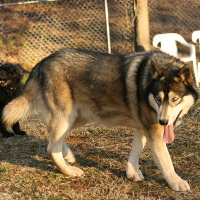 |
American Tundra Shepherd Dog |
|
He is not recognized by the F.C.I. |
Origin |
U.S.A. | |
Translation |
Francis Vandersteen | |
This breed is also known as |
Tundra Shepherd Dog
|
| The American Tundra Shepherd Dog is an even-tempered, obedient dog, totally devoted to its master and rather reserved with strangers - which makes it a good watchdog. Intelligent, observant, energetic and athletic, American Tundra Shepherd Dogs are enduring and versatile dogs that make good specimens for dog sports such as agility and obedience. He also has a very good memory and is capable of learning many commands. He can make a good working dog, a role for which he was developed, as well as a good companion for family life, although it's always best to channel him into one or the other activity. All they need is enough space to exercise, preferably in a fenced-in area, as they tend to be adventurous. Likewise, it's best to keep them on a leash when out walking. They can be gentle to moderately aggressive, depending on the individual. Training and socialization should start as soon as possible. The American Tundra Shepherd Dog is the result of an experiment conducted by the U.S. Army to create a breed with superior abilities, greater stamina, endurance and intelligence, intended for military service in Korea and Vietnam. In the late 60s, Frank Catania, a military dog trainer and veterinary technician, crossed an army German shepherd with an Alaskan wolf (Canis lupus tundrarum). Initially supported by the government, the program was eventually abandoned after several years spent trying to create a stronger sentry dog with a high tracking instinct. By 1976, however, several breeders were interested in the offspring of this experiment, as the larger, stronger dogs seemed to be free of the health problems usually associated with German Shepherds. However, a few enthusiasts decided that the American Tundra Shepherd Dog should be established as a breed distinct from the German Shepherd, and not just as a source of new blood. Since then, they have been trying to develop a consistent type. The percentage of wolf blood is said to be around 25% in current subjects. The coat is thick and hard, with hair that can be short or long. Color ranges from pure white to black, creamy white with black markings, sand, agouti gray, brindle and black and tan. These are very hardy dogs, able to withstand harsh environments, but not made to live outdoors all the time. The average size is between 63.5 cm for females and 79 cm for males, weighing between 50 and 60 kg. |






 English (United Kingdom)
English (United Kingdom)